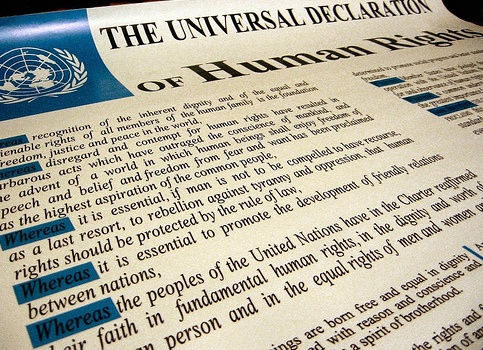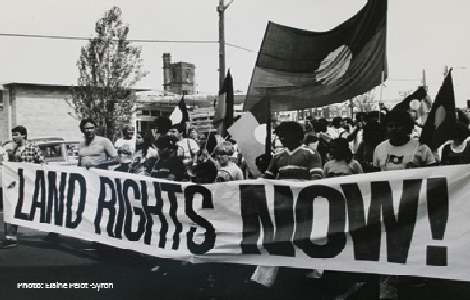An introduction to the indigenous land rights articles
November 29, 2011 by Carol Robb, Professor of Christian Social Ethics at San Francisco Theological Seminary and the Graduate Theological UnionThe assignment in a current doctoral seminar in distributive justice: Write an article to a general audience about a particular case of indigenous people struggling to regain land rights. In the footnotes engage a political theorist who has proposals for economic justice in our time. The challenge is to assess the effectiveness, relevance, or helpfulness of some of the most famous justice theorists to the question of how to justify, or argue against, the return of land to indigenous people. Go!
The Universal Declaration of Human Rights, adopted by the United Nations General Assembly on December 10, 1948, is an act of public and political ethics. It shares moral ground with many of the church’s social justice campaigns over the years; but it also challenges some stances churches have taken. All nations’ representatives to the drafting process wanted a document that could be adopted by nation states independent of religious confession. The 2/3 world nations, particularly small nations, pushed hard for a strong document, and it emerged as one that, with the exception of self-determination of peoples,[i] emphasizes rights of individuals. Yet all the rights are treated as interdependent, so that the civil and political rights are related strongly to economic, social, and cultural rights. While these rights are universal, held equally by all human beings, nation states have the responsibility to implement them for their citizens and foreigners within their borders. Drafters of the Declaration were from Canada, France, the U.S., Lebanon, Chile, and the USSR. Just one country, South Africa, appeared to be fundamentally opposed to the Declaration.[ii]
___________________________________________
The challenge is to assess the effectiveness, relevance, or helpfulness of some of the most famous justice theorists to the question of how to justify, or argue against, the return of land to indigenous people. Go!
___________________________________________
The self-determination of peoples is the right very often at stake when indigenous people struggle to regain land rights, as land is of particular spiritual and cultural significance to the identity of many peoples. It took 25 years to draft and pass the Declaration on the Rights of Indigenous Peoples, adopted by the General Assembly of the United Nations September 13, 2007. Article 8 of this declaration states that Indigenous peoples and individuals have the right not to be subjected to forced assimilation or destruction of their culture, and states shall provide effective mechanisms for prevention of, and redress for, any action which has the aim or effect of dispossessing them of their lands, territories or resources.[iii] While human rights theory is generally characterized as political ethics, because land is not only key to many peoples’ cultures but also to their economic survival, land rights struggles are also matters of distributive justice, which brings us back to that doctoral seminar.
The Human Rights Day issue of Unbound includes articles written by students in that class. Land rights struggles in their articles are occurring now in Hawaii, northern California, British Columbia, and South Korea. Each instance of struggle reflects lifeways in conflict with dominant cultures’ property rights and/or perceptions of security and development interests. We might use these articles to question how churches position themselves in relation to indigenous peoples’ rights to self determination.
[i] Article 1 of both the International Covenant on Civil and Political Rights and the International Covenant on Economic, Social and Cultural Rights, states “All peoples have the right of self-determination. By virtue of that right they freely determine their political status and freely pursue their economic, social and cultural development.” The United States has signed both Covenants, but has ratified only the Covenant on Civil and Political Rights.
[ii] For a good introduction to the Universal Declaration of Human Rights, see Jack Donnelly, Universal Human Rights in Theory and Practice, second edition (Ithaca and London: Cornell University Press, 2003). This short description of the Declaration can be found on pp. 22-25.
[iii] When the United Nations Declaration on the Rights of Indigenous Peoples was passed, four nations opposed it: the U.S., Canada, New Zealand and Australia. In 2009, Australia reversed its position and formally endorsed the Declaration. In 2010 Canada and New Zealand endorsed it. And the last hold-out, the United States, under President Obama, announced December 16, 2010 that the U.S. would reverse the position of the Bush administration and become the last nation to drop its opposition to the Declaration.
Carol Robb is Professor of Christian Social Ethics at San Francisco Theological Seminary and the Graduate Theological Union. She has written on econmic ethics, feminist ethics, and environmental ethics, and her most recent publication is Wind, Sun, Soil, Spirit: Biblical Ethics and Climate Change (Fortress, 2010). She is currently doing research on indigenous people’s land rights.
Banner photo by Joe Mabel.








Unbound Social